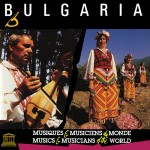

Gajda players and dancers, Koprivštica Festival, 2005. (Mike Harkin)
Koprivštica (official name: Национален събор на народно творчество—National Festival of Folklore) is a Bulgarian national folklore festival that is held every few years, typically, once every five years, in the historic town of Koprivštica. It draws visitors from all over the world, including many from North America. In July, Joan Hantman posed this question on the EEFC listserv:
Does anyone know the dates of the Koprivshtitsa festival for next year? I’m trying to plan ahead.
Responses to Joan’s question—and to a similar one posted in mid-October by Whitney Neufeld-Kaiser—included speculations and eventual confirmation about the dates, along with various resources that could be helpful to someone trying to plan a trip for next summer. Here are some highlights.
Koprivštica Festival Dates: Aug 7-9, 2015
�Workshops and Tours
Larry Weiner announced this on July 31 and posted a more detailed announcement on Oct. 22:
2015 Bulgarian Folk Music & Dance Seminar in Plovdiv, Bulgaria
July 31-August 6, 2015 (immediately before Koprivshtitsa festival; the seminar ends the day before the festival begins; a chartered bus from Plovdiv to Koprivshtitsa will be available for seminar attendees on August 6th).
This seminar, now in its 11th year, offers a special experience for non-Bulgarians (and Bulgarians interested in connecting with their “roots” music and dance) who want a more in-depth opportunity to learn traditional instruments, singing styles, and dance than is normally possible for groups or individuals traveling to Bulgaria. This rich and unique program couples the teaching expertise of instructors at the Academy of Music, Dance and Fine Arts in Plovdiv (http://www.artacademyplovdiv.com/) with the traditional music and dance wisdom of tradition bearers from around Bulgaria. The dance program features different groups of dancers and musicians throughout the week, teaching dances from their own villages. A Bulgarian language class will also be offered, as well as optional evening social activities.
Special 15% discount for EEFC members!
Website
Facebook
Paula Davis mentioned this on June 16 and Joseph Benatov posted the link on Oct. 16:
Jim Gold’s Tour
Sofia, Plovdiv, Bansko, Veliko Turnovo, Koprivshtitsa Folk Festival
August 3-16, 2015
Depart from JFK airport in New York City
Website
Link posted by Rick Speer on Nov. 2:
Nina Kavardjikova Tour
Sofia, Koprivshtitsa, Shiroka Luka, Sofia
August 1-14, 2015
Flyer for Nina K’s Koprivshtitsa tour is online at this link [PDF format]
Mentioned by Dave Golber (Oct. 16, 2014):
Goran Alački is planning his seminar in Macedonia to end at a convenient time so people can get over to Koprivshtitsa afterwards.
Goran Alački’s Macedonian Pearl Seminar—10th Anniversary!
July 25-August 3, 2015
Berovo, Macedonia
Website
Tips
Wally Washington posted this on Oct. 22:
It’s been more than 20 years since I have been, though I doubt that this has changed, but for the folks looking for tips on the Koprivshtitsa festival there is one point that should be made explicit. There is not much in the way of hotel space in Koprivshtitsa, or even very close by. That is one reason for the popularity of tours; the tour will have the housing aspect taken care of.
Can you get to the festival on your own? Sure, people do it every fest. Can you get a room in town? Sure, at least maybe. One year I got a room for Saturday night on Saturday morning. But you’d better be pretty flexible if you attempt that—I had a backup place to stay an hour away with the tour I was on. I don’t know that I would encourage someone to try to go on their own.
And as in all things, the different tours will have different styles and appeal to different people. One year when I was more on top of things I almost posted to this list an only slightly snarky listing of my impressions of the different tours. So it may be wise to pay attention to which tour you are signing up for. Though I suppose they will all get you to the festival each morning. (Though I do have a memory of some tours not getting there in time for Friday of the fest.)
And Barbara Babin posted on Oct. 23 that she had a contact for some rooms for rent during the festival, but on Oct. 29 posted that that they were now all taken.
It can pay off to follow the listserv on a daily basis! You can choose to receive individual messages in your email inbox or receive a daily digest. Click for information on subscribing.






 As a child, I grew up in a Russian Orthodox parish [in the U.S.] where many of the parishioners were deformed by WW I, the Stalin terror or WW II . . . eyes, parts of faces, missing body parts, that sort of thing. In many cases combined with the attendant psychiatry as well . . .
As a child, I grew up in a Russian Orthodox parish [in the U.S.] where many of the parishioners were deformed by WW I, the Stalin terror or WW II . . . eyes, parts of faces, missing body parts, that sort of thing. In many cases combined with the attendant psychiatry as well . . .
 [In response to a post from Dean Brown, who recently tracked down a particular Romani tune taught by Carol Silverman at an EEFC workshop by finding the entire 1982 Jugoton album on YouTube.]
[In response to a post from Dean Brown, who recently tracked down a particular Romani tune taught by Carol Silverman at an EEFC workshop by finding the entire 1982 Jugoton album on YouTube.]